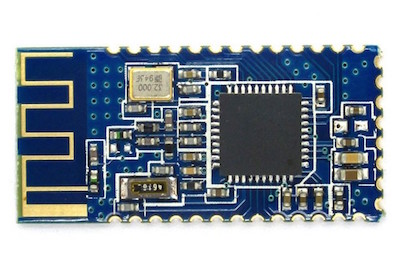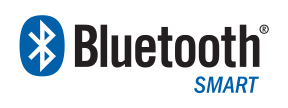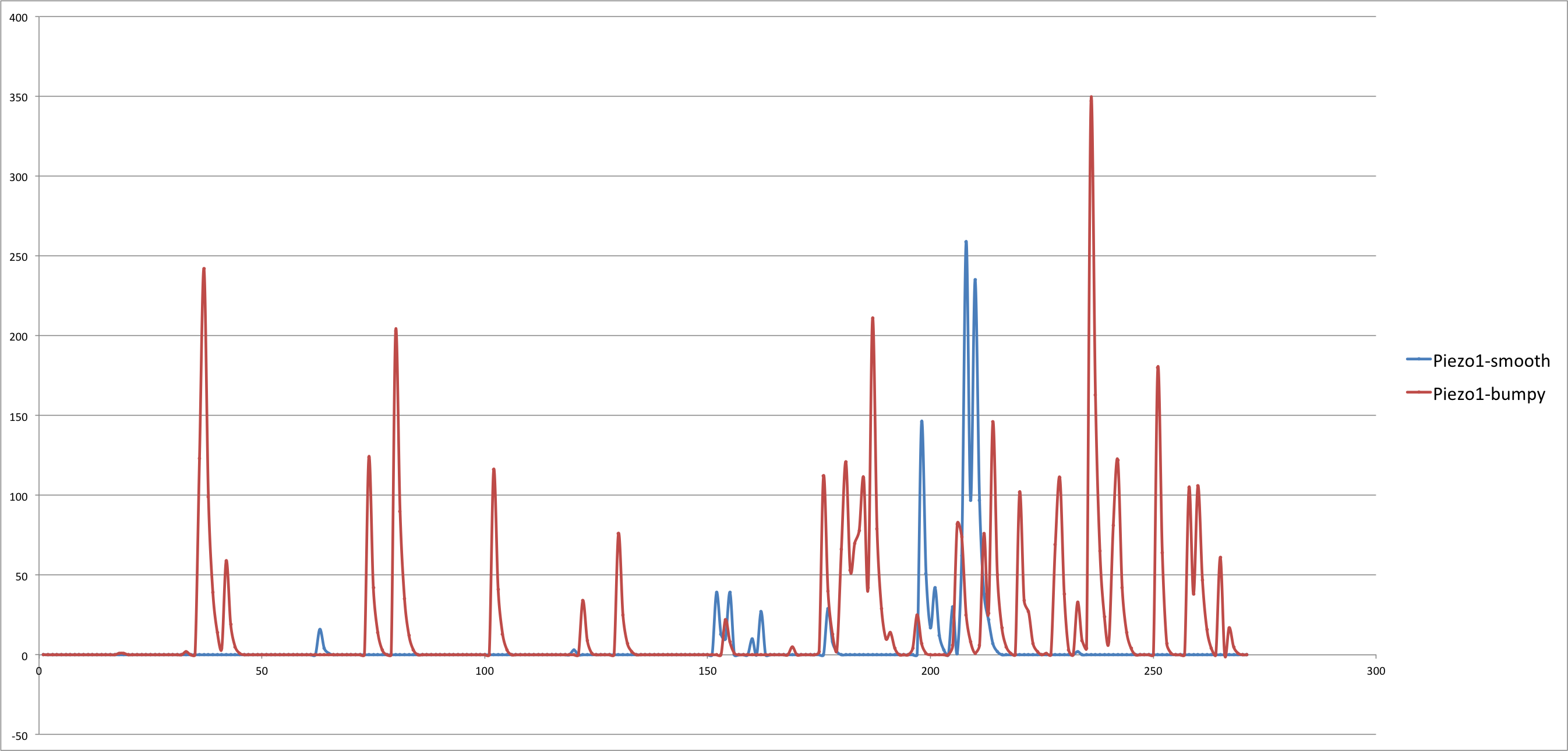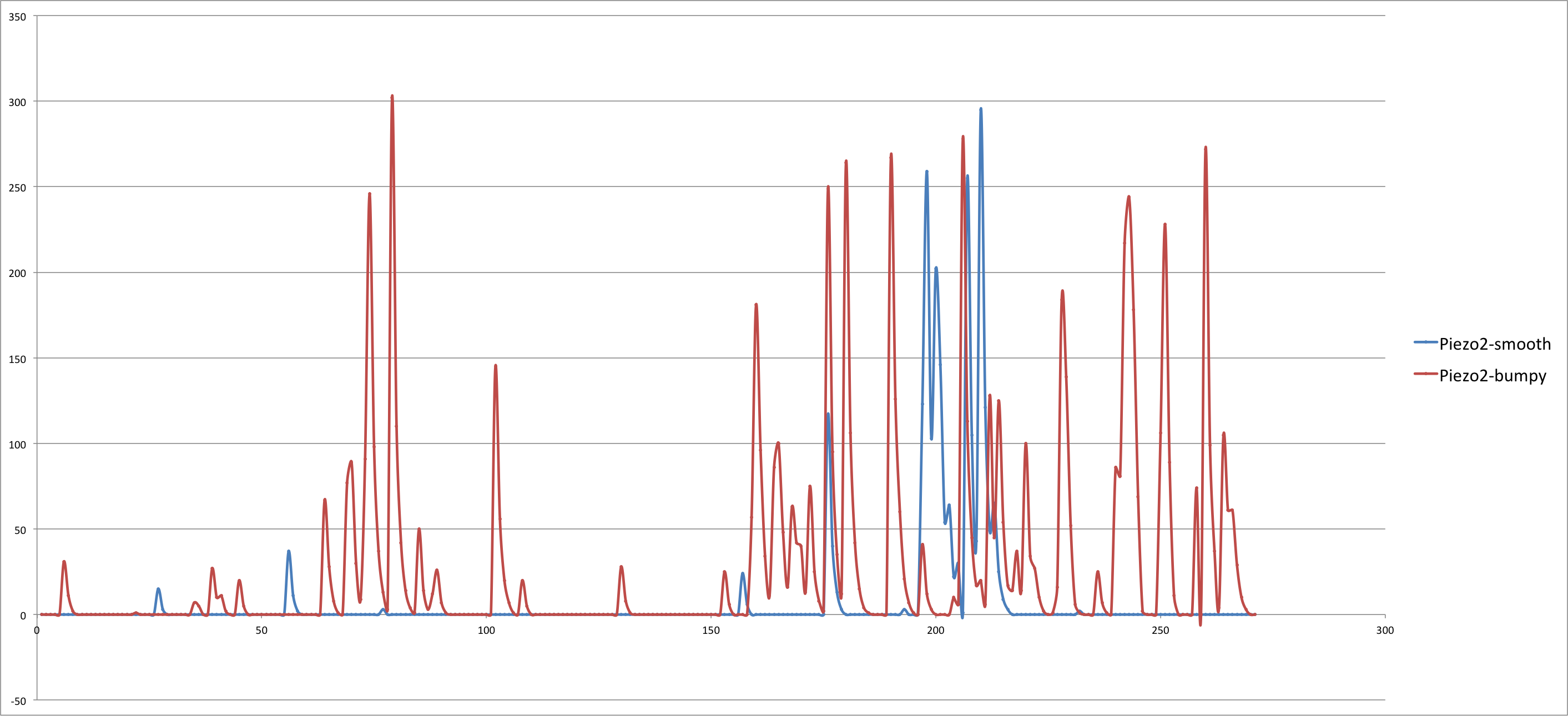Bicycle-Mounted
Road Quality Sensor
MAS.836 Final Project
Caroline Jaffe
May 2016

Background & Motivation
- Data on bicycles is extremely sparse (e.g. state of the art is bike counter)
- Better data can help cities/ advocacy groups make better choices
- Way to leverage public resource to learn more about city (e.g. better sensors on Hubway)
Design

- Accelerometer and piezo films on the handlebars
- Chip selection and general design
- Power considerations
- Communications and data
Design: Piezo Circuit

- Non-inverting amplifier & peak detector
Design: Piezo Circuit
- Tested to see output range (0 - .75 V), and choose R's to scale to 0 - 3.3 V (R1 = 2.87 kOhms, R2 = 10 kOhms for A = 4.4)
- Found frequency and appropriate peak detector values (C = 10 uF, R = 6.34 kOhms)
- Noted that piezos should be close to amplifier
Design: PCBs

- Regulated power source
- Accelerometer
- LEDs for debugging
- SPI programming header
- Peak detectors & non-inverting amps (separate)
- Serial interface
Embedded Programming: Piezos
void setADC1(){
ADMUX = (0 << REFS1) | (0 << REFS0) // Vcc ref
| (0 << MUX5) | (0 << MUX4) | (0 << MUX3) | (0 << MUX2) | (0 << MUX1) | (0 << MUX0); // ADC0
}
void setADC2(){
ADMUX = (0 << REFS1) | (0 << REFS0) // Vcc ref
| (0 << MUX5) | (0 << MUX4) | (0 << MUX3) | (0 << MUX2) | (0 << MUX1) | (1 << MUX0); // ADC1
}
Originally using Arduino IDE......ran into some space issues!
Embedded Programming: Piezos
Embedded Programming: Accelerometer
ret = I2C_master_write(data,1,I2C_slave_address);
ret = I2C_master_read(data,6,I2C_slave_address);
put_char(&serial_port,serial_pin_out,data[0]);
put_char(&serial_port,serial_pin_out,data[1]);
put_char(&serial_port,serial_pin_out,data[2]);
put_char(&serial_port,serial_pin_out,data[3]);
put_char(&serial_port,serial_pin_out,data[4]);
put_char(&serial_port,serial_pin_out,data[5]);
- Also originally used Arduino IDE, switched to using straight C, bit-banging implementation of I2C via Neil
- Accelerometer is I2C "slave", Attiny44 as I2C "master" reads 2 bytes of acceleration data for each axis
- Sends high and low bit over serial
Embedded Programming: Accelerometer
Programming: Communications
- Sensor sends data over BLE using HM-10 module
- Allow computer to read from BLE using a variety of node modules (noble, virtual serial-port, serial-to-socketio)
- Front-end: further processing and visualization
- Advantages and disadvantages



Programming: Front End

- JS, Jquery & D3
- Streaming data, not saving data*
- See actual data, but also a visual indicator based on color of circles
- Basic quality and detection logic
- See it in action...
*N.B. Added download data functionality to see snapshot of the data
Sensors in Action!
Sensors in Action!
Sensor Data
Piezo1 data from Bumpy vs Smooth Road

each time division ~ 50 ms
Sensor Data
Piezo2 data from Bumpy vs Smooth Road

each time division ~ 50 ms
Live Demo*
*only try this if you are running the app.js file locally, within range of the sensor, etc!
Challenges, Lessons
& Next Steps?
- Integration is hard
- Careful systems thinking and design is important
- Make it more mobile - use an app!
- Integrate GPS readings
- More & better signal processing and detection logic
- Better integration into the bicycle
- Data storage & longer-term analysis
Thanks!
cjaffe@media.mit.edu
See project files on Github